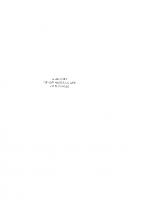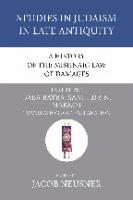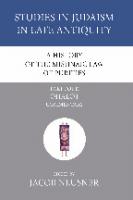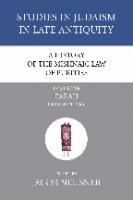A History of the Mishnaic Law of Damages, Part 2: Baba Mesia 9781556353666, 1556353669
The history of Jews from the period of the Second Temple to the rise of Islam. From 'A History of the Mishnaic Law
144 77 16MB
English Pages 194 [195] Year 2007
A HISTORY OF THE MISHNAIC LAW OF DAMAGES
JACOB NEUSNER
BABA MESIA
TABLE OF CONTENTS
BABA MESIA CHAPTER TWO
BABA MESIA CHAPTER THREE
GENERAL INDEX
Recommend Papers

- Author / Uploaded
- Jacob Neusner (editor)
File loading please wait...
Citation preview
A HISTORY OF THE MISHNAIC LAW OF DAMAGES PART TWO
STUDIES IN JUDAISM IN LATE ANTIQUITY EDITED BY
JACOB NEUSNER
VOLUME THIRTY-FIVE
A HISTORY OF THE MISHNAIC LAW OF DAMAGES PART TWO
A HISTORY OF THE MISHNAIC LAW OF DAMAGES BY
JACOB NEUSNER University Professor The Ungerleider Distinguished Scholar of Judaic Studies Brown University
PART TWO
BABA MESIA TRANSLATION AND EXPLANATION
Wip£&Stock PUBLISHERS Eugene,Oregon
Wipf and Stock Publishers 199 W 8th Ave, Suite 3 Eugene, OR 97401 A History of the Mishnaic Law of Damages, Part 2 Baba Mesia By Neusner, Jacob Copyright©1983 by Neusner, Jacob ISBN 13: 978-1-55635-366-6 ISBN 10: 1-55635-366-9 Publication date 3/20/2007 Previously published by E. J. Brill, 1983
For my brother Judge Frederick D. Neusner U.S. Department of Labor
TABLE OF CONTENTS Preface .......... . Abbreviations and Bibliography Transliterations Introduction.
.
IX
xv XXX
1
I.
Baba Mesia Chapter One .
16
II.
Baba Mesia Chapter Two.
26
III. IV. V.
Baba Mesia Chapter Three
41
Baba Mesia Chapter Four.
53
Baba Mesia Chapter Five .
66
VI.
Baba Mesia Chapter Six
97
VII.
Baba Mesia Chapter Seven
109
VIII. IX. X.
Baba Mesia Chapter Eight
121
Baba Mesia Chapter Nine.
132
Baba Mesia Chapter Ten .
149
Index.
156
Index to Biblical and Talmudic References
156
General Index . . . . . . . . . . . .
162
PREFACE Baba Mesia stands at the head of the Mishnah's tractates, because it is exceptionally interesting and exhibits some of Mishnah's most disciplined and sustained formal constructions. Whole chapters adhere to a single syntactic pattern and express conceptions of unusual cogency and conceptual sophistication. Tosefta to this tractate for its part undertakes an unusually ambitious project of amplification and secondary expansion, as well as providing its usual supplementary information. Along with its companions, fore and aft, Baba Mesia forms the introductory curriculum for Mishnaic and Talmudic studies. The reason is not difficult to imagine. The framers of the curriculum choose for beginners those tractates which speak of commonplace things and express accessible and everyday principles. My commentary in no way claims to command the heights of the historical exegesis of this tractate. It purports only to say what the tractate means in its original formulation, that is, what the people who make things up · this way wish to say in their own day and to their own contemporaries. The character of this translation and explanation in detail expresses the purpose of the larger work of which it is part. To present a history of the Mishnaic law, I have to give an account of the document itself, first of all to state what I believe Mishnah says, in a rendition, in English, as close to the formal and syntactical character of the Hebrew as English permits. This I do in the translation, which itself is a commentary in its word-choices, patterns, and its version of the division of sentences into stichs, of paragraphs into sentences, and of chapters into paragraphs. (But this last depends, for the convenience of the reader, on the printed text of J::Ianokh Albeck.) The translation makes no important contribution to the explanation of realia or the identification of various places, persons, and things, mentioned in the document. What it does contribute is the first translation of a rabbinic document to take fu.11and faithful account of the rigidly formalized, public and anonymous character of Mishnaic language. I provide complete form-analytical translation of Mishnah and of Tosefta. The explanationis rather different from any of its predecessors, so different that it must be called "explanation." For if what have been done in the past are called commentaries, this cannot be represented as a commentary at all. What I do not say invariably is more important than what I choose to discuss. By radically revising and abbreviating the established exegetical agendum, I believe I have made my richest contribution to the interpretation of Mishnah. This is in two aspects.
X
PREFACE
First, I have tried to force Mishnah to serve as its own commentary. [ do so by relying heavily upon those formal and even substantive traits of the document which serve to provide a clear account of Mishnah's meaning and message. I pay careful attention to matters of form and formulation. We shall see time and again that principally through setting up a contrast, placing of a phrase, for emphasis, or other obvious linguistic and syntactical modes of highlighting its rneaning, Mishnah serves as its own first, and therefore best, commentary. Second, I have revised what I believe to be the definition of those issues appropriate to, and even acceptable for, exegesis of Mishnah in particular, as a singular document of ii-s period. This last point requires some amplification. There are two sides to the problem of explaining what Mishnah means. Both of them are generated by one absolutely false conception, or, more accurately, a single misleading analogy. The first problem is the bringing to Mishnah of issues clearly extraneous to its original meaning. 'fhis set of comments plainly is needless because the issues are generated later problems and questions. They are quite naturally addressed to _;\Jishnah, however, by people ,,vbo assume Mishnah speaks to them and therefore must address issues of importance to them. This ahistorical apprnach is pCJssiblyvalid for the generating and unfolding of law. But it is not correct for the interpretation of what ::'vlishnah as a concrete









